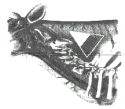

To send a message to an author, click on the author's name at the end of the article.
This Month in Ag Connection | Ag Connection - Other Issues Online
In the early 1990's, the cattle industry began to move to Beef Quality Assurance (BQA) protocols that are now in wide spread use. Injection site lesions were one of the main problems addressed. The effort was very successful with beef quality audits showing a reduction of injection lesionsin the top butt, round and loin. The preferred injection site introduced in the early 90's is shown in the larger triangle in the figure below.

The food industry has introduced new cuts utilizing the chuck and switched to a modified atmosphere (MA) packaging process for case-ready meats. The MA packaging contains 80% oxygen and 20% carbon dioxide mixture, which can cause a green discoloration of meat close to the injection site. To remedy this marketing problem, the BQA program is promoting the smaller injection area triangle shown in white.
(Author: Mark Stewart, Livestock Specialist)
This Month in Ag Connection | Ag Connection - Other Issues Online

Do agricultural producers think a bioterrorist attack might strike water, livestock, crops or the U.S. food supply? How can they prepare for or respond to such incidents? The Extension Disaster Education Network (EDEN) will provide homeland security education for farm and non-farm industries and individuals to answer these types of questions.
A web-based survey will ask producers across the country for their opinions on such biosecurity and agroterrorism topics. The producer survey results will guide what types of educational programs should be offered on agricultural biosecurity. The EDEN project will help measure agricultural producers' perceptions about biosecurity issues on the farm.

To take the survey, producers may visit the EDEN web site at http://eden.lsu.edu/Pages/default.aspx and click on "Homeland Security Surveys," then click on "Survey of Ag and Horticulture Producers". The survey is anonymous, takes less than ten minutes, and needs to be completed by the end of November. For producers without web access, stop by your local Extension office.
(Author: David Baker, Assistant Director, Ag. Extension, University of Missouri)
This Month in Ag Connection | Ag Connection - Other Issues Online

Physical, environmental, nutritional and social stresses commonly impact calves at weaning. Traditional weaning systems typically stack two or more of the stressors together and cause problems with reduced calf health and performance.
When designing weaning programs to reduce the number of stressors occurring at once, consider the following:
(Author: Mark Stewart, Livestock Specialist)
This Month in Ag Connection | Ag Connection - Other Issues Online
Pasture weaning offers a low-stress alternative to conventional drylot weaning programs. In a pasture weaning program, it is important to have high quality pasture available at weaning. For fall weaned calves, hay field re-growth or stockpiled fescue provide excellent choices for pasture weaning.
The idea that weaning fences need to be five feet high and "chicken tight" applies to traditional drylot weaning programs where calves are looking for a way to escape multiple stressors.

With pasture weaning, three-strand electrified hi-tensile fences have been used very successfully. For cattle with limited exposure to electric fence, a pasture with either woven wire perimeter or at least five electrified wires will probably be required for weaning. Adding an offset hot wire to an existing 4 or 5 strand barbed-wire fence may also serve to keep calves in place.
'Across-fence weaning' reduces social stress by allowing the dam and calf visual and scent contact.
(Dr. Jim Gerrish, Assistant Professor, Forage Systems Research Center)
This Month in Ag Connection | Ag Connection - Other Issues Online

To optimize pig performance, monitor the following feed quality issues:
This Month in Ag Connection | Ag Connection - Other Issues Online

If you have hay to sell, click here to view hay market web site.
(Author: Don Day, Ag. Eng./Info. Tech. Spec.)
This Month in Ag Connection | Ag Connection - Other Issues Online

As the hog market and feed prices fluctuate producers need to determine their optimal market weight. The table below indicates at low hog prices and high feed costs, economic efficiencies may be obtained by marketing at lower weights. Remember - these tables only account for feed costs - other costs are not included.
Historically shackle space has become limited in November and December. Schedule shackle well in advance!
| Advantage Of Feeding A Hog From 230 - 280 Pounds If Feed Efficiency Is 3.8 |
||||||
|---|---|---|---|---|---|---|
| $/Ton of Feed | $80 | $90 | $100 | $110 | $120 | $130 |
| Mkt. Hog Value | Net Gain/Head, $ | |||||
| $40/100 | 12.40 | 11.45 | 10.50 | 9.55 | 8.60 | 7.65 |
| $25/100 | 4.90 | 3.95 | 3.00 | 2.05 | 1.10 | 0.15 |
| $20/100 | 2.40 | 1.45 | 0.50 | -0.45 | -1.40 | -2.35 |
| $15/100 | -0.10 | -1.05 | -2.00 | -2.95 | -3.90 | -4.85 |
(Authors: Marcia Carlson, Assistant Professor, Animal Science, UMC; Tom Fangman, Veterinary Swine Specialist, UMC; Mark Stewart, Livestock Specialist)
This Month in Ag Connection | Ag Connection - Other Issues Online

The annual gift exclusion has been limited to $10,000 for a number of years. Starting in 2002, each person (donor) can give up to $11,000 of assets each calendar year to as many people as they are financially able and willing - without incurring any federal gift tax liability. The annual gift exclusion provides a means of transferring a substantial amount of wealth out of an estate over a relatively short period of time.
Gifts to be eligible for the annual exclusion must be gifts of a "present interest". In contrast, the transfer of an asset while retaining the right to the income from that property for the remainder of your life is a gift of a future interest and would not qualify for the annual gift exclusion.
See IRS Publication 950, Introduction to Estate and Gift Taxes: http://www.irs.gov/pub/irs-pdf/p950.pdf
(Author: Parman R. Green, Ag Business Specialist)
This Month in Ag Connection | Ag Connection - Other Issues Online
Publishing Information
Ag Connection is published monthly for Northeast and Central areas of Missouri producers and is supported by the University of Missouri Extension, the Missouri Agricultural Experiment Station, and the MU College of Agriculture, Food and Natural Resources. Managing Editor: Mary Sobba.